Long Covid Risks: 2023 Update
post by Elizabeth (pktechgirl) · 2023-05-06T18:20:01.259Z · LW · GW · 11 commentsContents
Summary Studies Nirmatrelvir and the Risk of Post-Acute Sequelae of COVID-19 (pre-print) Long COVID after breakthrough SARS-CoV-2 infection Long covid outcomes at one year after mild SARS-CoV-2 infection: nationwide cohort study None 11 comments
Back in 2021 I wrote a post estimating the risk of long covid. Recently a client hired me to do an update, focusing on changes induced by Paxlovid and vaccination. This was a <5h project and the literature wasn’t very rich so nothing I say here is conclusive, but nothing I said last time was conclusive either so let’s enjoy this together.
Some caveats:
- I spent 5 hours on this, and that includes client-specific work I’m not including here.
- Research that met my standard was really scarce; ultimately each conclusion is based on a single study. My goal was data that includes a large population not selected for having long covid, where reporting was automated so you don’t need to worry about response bias. In practice, this means I used data from large medical systems with integrated reporting, like the American Department of Veteran Affairs, national medical systems, and HMOs. Surveys from long covid support groups were ignored with prejudice.
Summary
Vaccination helps, a bit: Given a medically diagnosed infection (which means it was serious enough to actually get you to the doctor), up-to-date vaccination lowers the risk of long covid by about 20% (this does not include the reduction in risk of having diagnosable covid in the first place, which is substantial).
Paxlovid helps, more: Nirmatrelvir, which is one of two drugs that make up Paxlovid, reduces long covid risk by about 30% for medically diagnosed infections (which means it was serious enough to actually get you to the doctor). An optimist might hope the other drug (which is in the same class, although most commonly used as an adjuvant) is also useful and round this to 50%.
Most symptoms are temporary: Long covid does tend to get better over time, but how quickly depends on the symptom. At one year post-infection, the rate of heart issues is nearly indistinguishable from controls, but cognitive issues have a 50% chance of persisting.
Calculate your absolute risk: Your absolute risk depends on your age and comorbidities. The measured risk for 70-year-old men (not controlling for comorbidities) of developing at least one serious sequelae of medically diagnosed covid n (which means it was serious enough to actually get the patient the doctor) is ~12%. If you want to norm this for your own demographic, you can get a very crude estimate by entering your demographic information in this calculator, dividing your risk of hospitalization by 3 and multiplying the total by 0.4 (which includes the 20% reduction from vaccination and the 50% reduction from Paxlovid). If you are a cis woman, multiply by 2 to account for increased risk (trans people: I have no idea, if you find good data please let me know).
I cannot emphasize enough how crude this is. I got that 3 by making up a 70 year old man with some common comorbidities, which has a risk of hospitalization of ~36%, and noticed 36/12=3. I don’t think The Economist has been keeping up to date with the latest strains of covid or even the impact of vaccination; these proposed calculations are strictly for order-of-magnitude estimates.
Sample calculation: a 35 year old woman with no comorbidities shows a 3.8% risk of hospitalization (with their data, which I believe is very old). 3.8%/3= 1.3%. 1.3%*0.4= 0.5%. Times 2 for being female = 1.0%. So a covid infection bad enough to require medical attention has a 1 chance in 100 of a serious persistent issue post-covid.
Studies
Nirmatrelvir and the Risk of Post-Acute Sequelae of COVID-19 (pre-print)
This study compared people who got covid and received Nirmatrelvir (half of Paxlovid). It used data from the American Department of Veteran Affairs, which means the participants are older (average age 65), overwhelmingly male (~90%), and very white (75%). Last time I checked maleness increases the risks of short-term covid consequences but decreases the risks of long term consequences, so good luck balancing that calculation.
The distribution of medication was not random. They don’t specify beyond this, but I assume VA doctors are more likely to aggressively treat patients who are sicker or have more co-morbidities, which should lead the study to understate the impact of treatment. Additionally they were only giving nirmatrelvir, which is one of the two drugs packaged together to make Paxlovid. I’m going to be an optimistic and assume the second drug was included for good reasons, which make this study underrepresent the usefulness of Paxlovid. But they don’t give the dosage at all, so there is a wildcard.
All that said: Nirmatrelvir was quite helpful, cutting the risk of long covid (PASC) at 90 days by ~25%, which in this group translated to 2.5 percentage points.
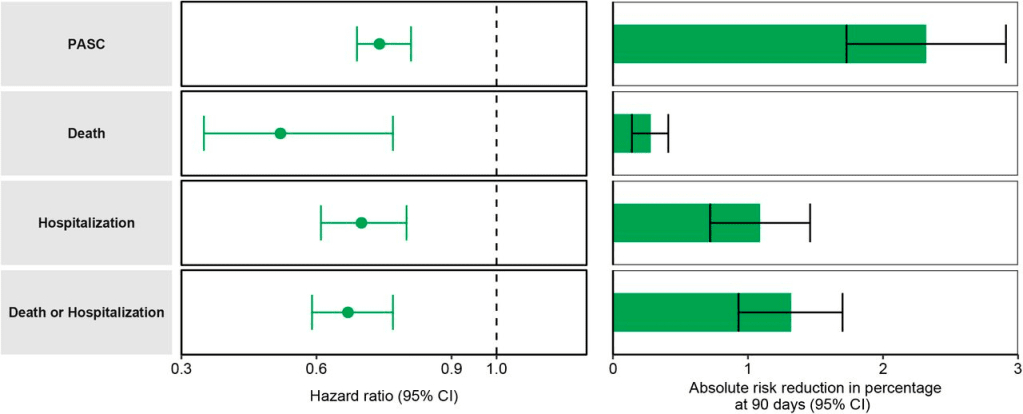
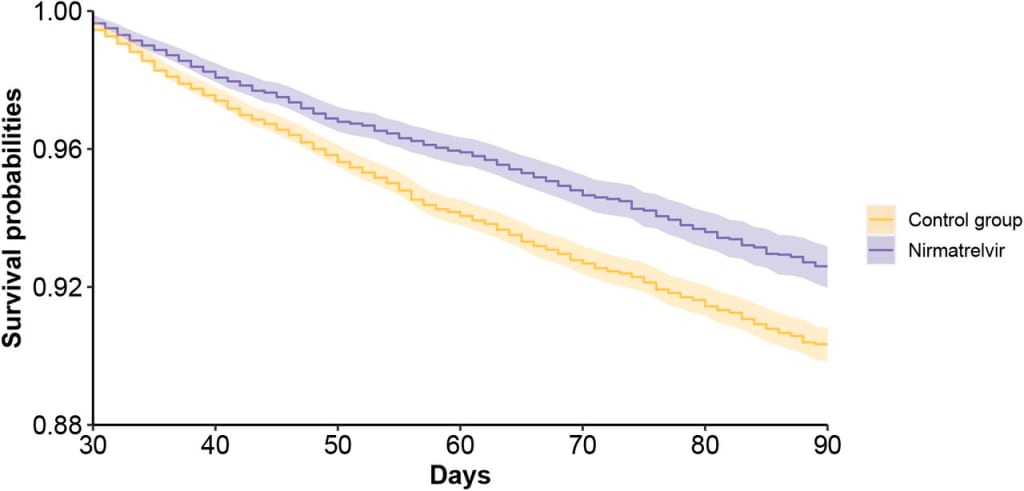
Survival here means “survived w/o long covid symptoms”. You might ask why that goes down over time, given some people recover between days 30 and 90. I believe the answer is that they didn’t check for symptoms’ persistence: any diagnosis of long covid issues put participants in the PASC bucket forever.
Effect by symptom:
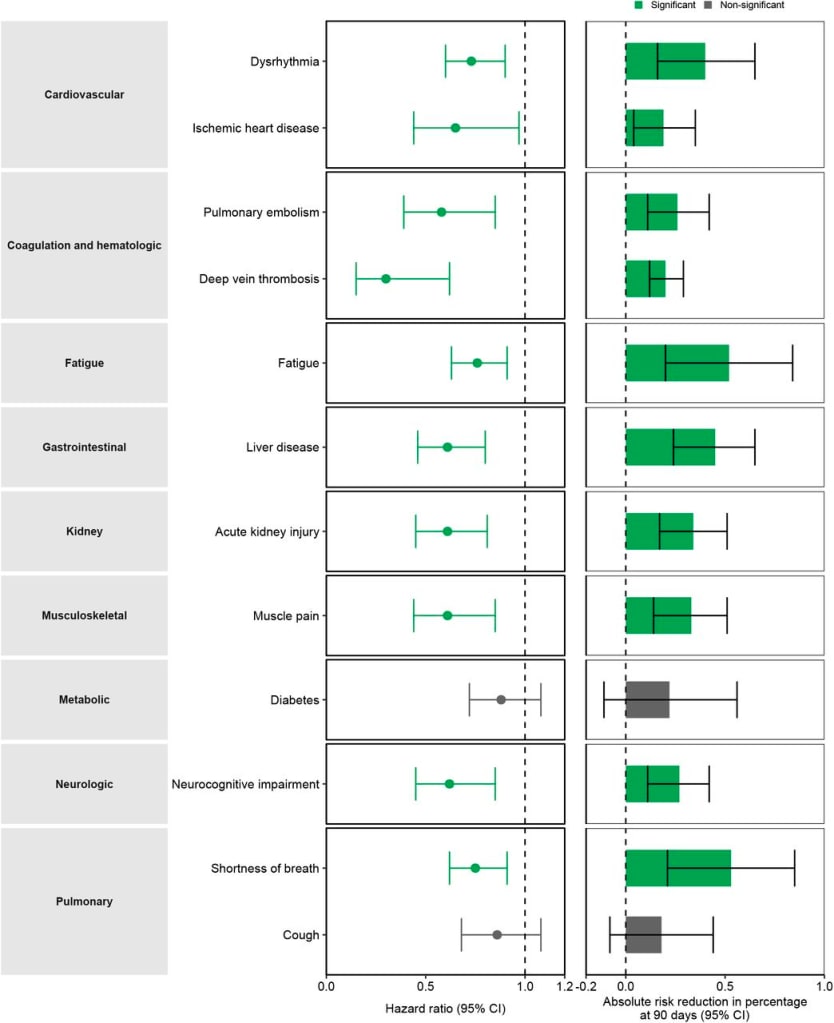
Long COVID after breakthrough SARS-CoV-2 infection
This is another study with VA data. They compared outcomes of infection after vaccination, compared with vaccinated controls.
Participants with infections after vaccination (aka breakthrough infections) had a 12 percentage point increase in risk of symptoms in 12 areas, compared to vaccinated people who didn’t get infected. Again, the study population is probably at higher risk than average due to age and associated comorbidities.
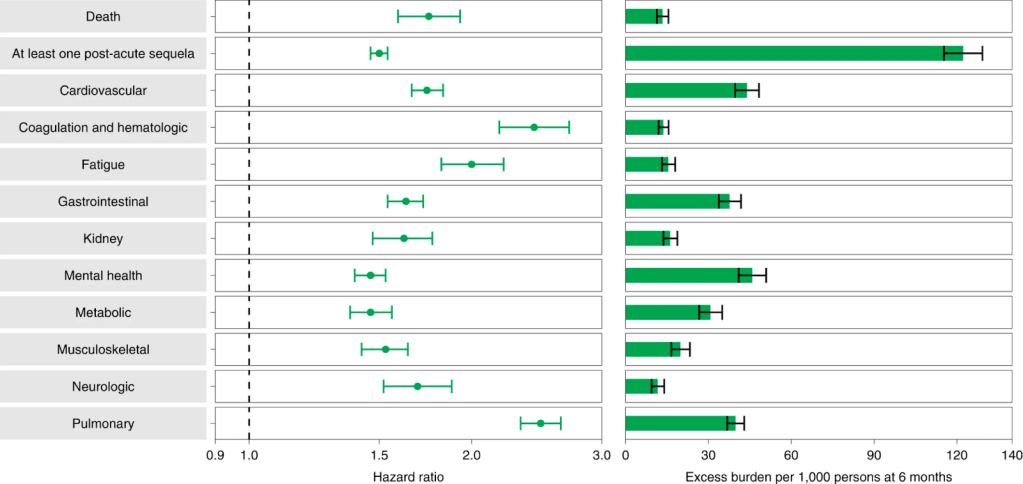
However, this risk is heavily concentrated among hospitalized patients:
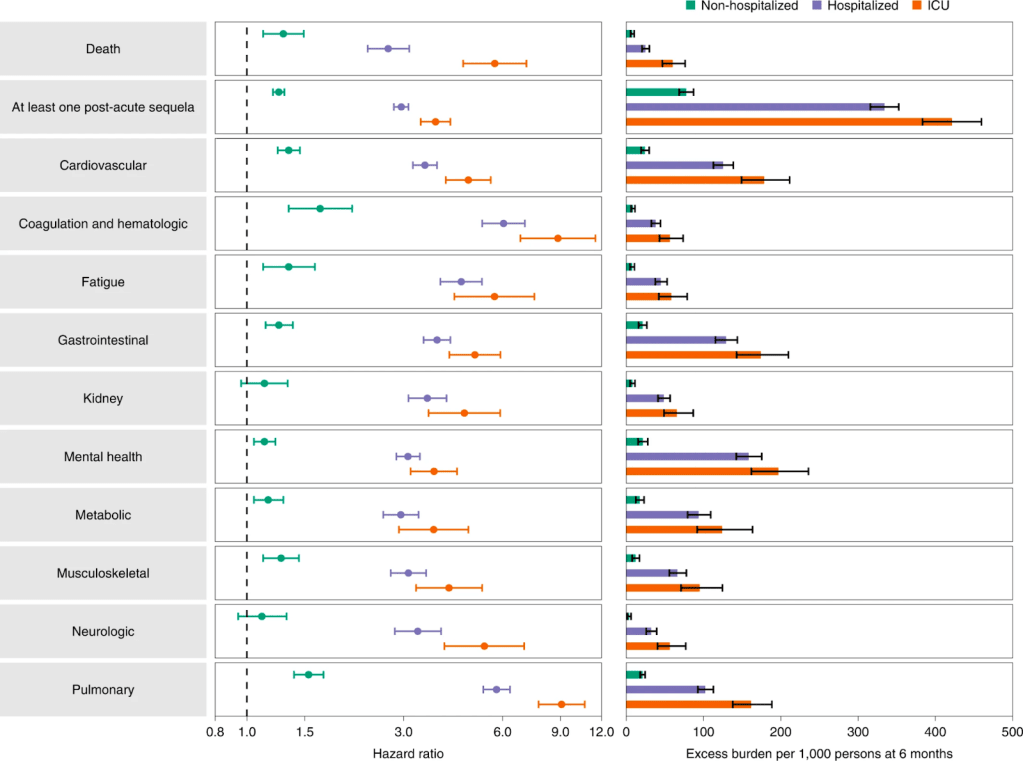
They also compared the risks to those of infections in unvaccinated people. Vaccination clearly helped, but not by as much as one would hope.
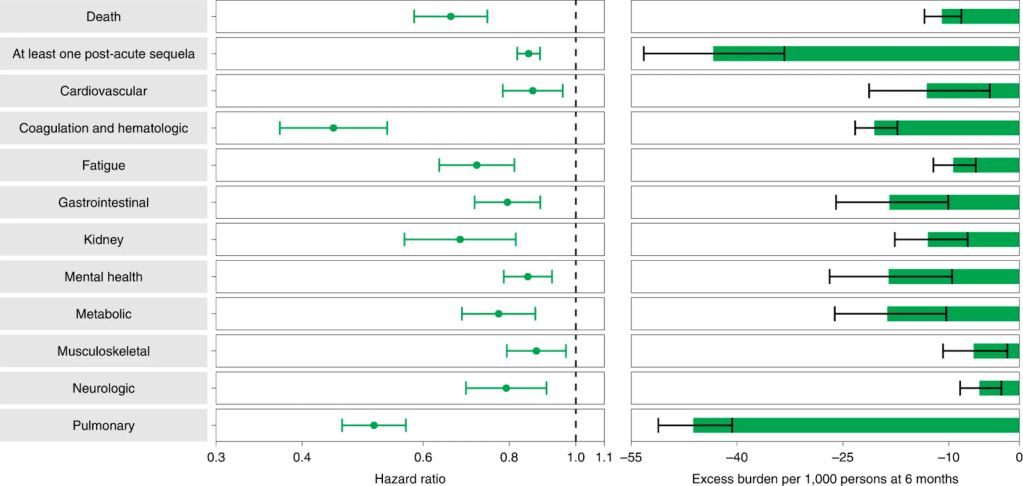
Just for fun, here’s the long-term risks of covid relative to the flu:
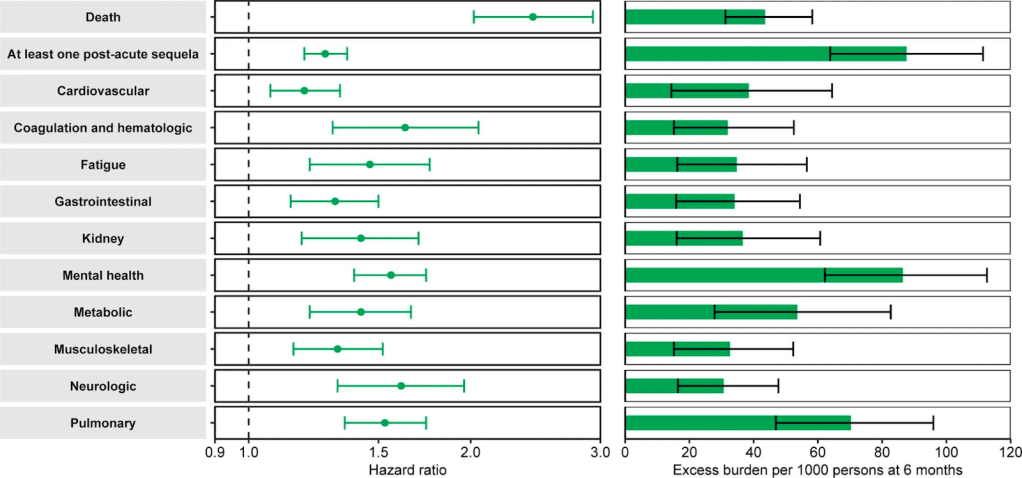
Long covid outcomes at one year after mild SARS-CoV-2 infection: nationwide cohort study
This paper looked at long-term health outcomes from an Israeli HMO. It mixed vaccinated and unvaccinated participants but held infection severity constant, which is unforgivable from an absolute risk estimation standpoint but probably fine for looking at the trajectory of recovery from long covid over time. “Mild” appears to mean “did not end up in the hospital”; however the case did need to be serious enough that it made it into medical records in the first place.
The general trend is “things get better”, with the rate of improvement varying by symptom type. Unfortunately cognitive effects are the slowest to resolve, with at best a 50% recovery rate one year out.
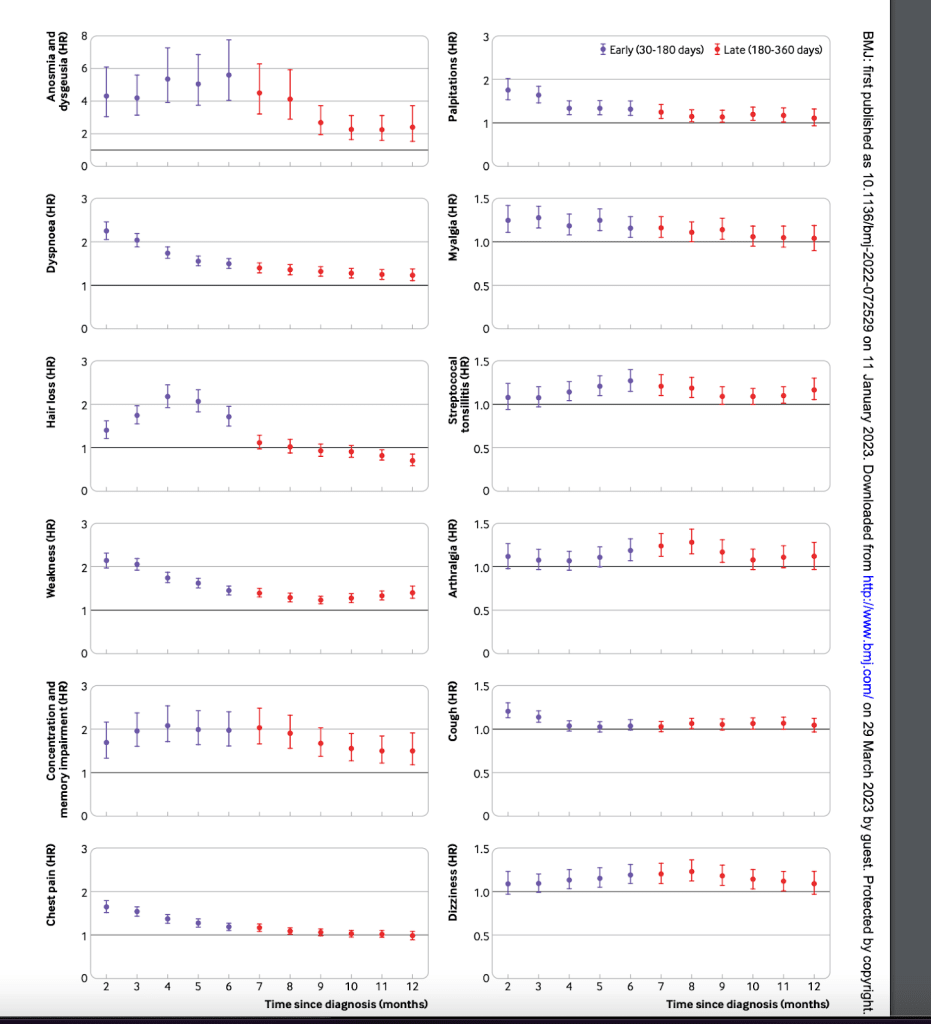
11 comments
Comments sorted by top scores.
comment by rossry · 2023-05-08T02:07:00.450Z · LW(p) · GW(p)
(You may well know this, but posting for the benefit of other readers.)
Nirmatrelvir, which is one of two drugs that make up Paxlovid, reduces long covid risk by about 30% for medically diagnosed infections (which means it was serious enough to actually get you to the doctor). An optimist might hope the other drug (which is in the same class, although most commonly used as an adjuvant) is also useful and round this to 50%.
...nirmatrelvir, which is one of the two drugs packaged together to make Paxlovid. I’m going to be an optimistic and assume the second drug was included for good reasons, which make this study underrepresent the usefulness of Paxlovid.
Wikipedia: Nirmatrelvir/ritonavir explains that ritonavir (the other drug) is commonly understood to be playing its role by inhibiting your body's breaking down nirmatrelvir, leading to higher serum concentrations at trough:
Nirmatrelvir is a SARS-CoV-2 main protease inhibitor while ritonavir is a HIV-1 protease inhibitor and strong CYP3A inhibitor. Nirmatrelvir is responsible for the antiviral activity of the medication against SARS-CoV-2 while ritonavir works by inhibiting the metabolism of nirmatrelvir and thereby strengthening its activity.
Wikipedia: Ritonavir adds some detail on this mechanism and adds that its helpful role in antiretroviral therapy for HIV is also commonly understood to be by inhibiting CYP3A4 (the human enzyme that breaks down many protease inhibitors like nirmatrelvir and ART cocktail components).
I don't have a head-to-head study of nirmatrelvir vs nirmatrelvir+ritonavir close at hand, but ritonavir is responsible for many-to-most of Paxlovid's drug-drug interactions, which are commercially negative for the manufacturer (Pfizer). Given that there's no real reason to add those side effects if the ritonavir weren't significantly helping, it seems pretty reasonable to update towards "ritonavir improves the efficacy of nirmatrelvir on at least one commercially-useful axis". That axis is likely not specific efficacy against Long Covid (which I think is not particularly relevant to Pfizer's approval path or commercialization strategy), though you might hypothesize that it would correlate.
comment by lillybaeum · 2023-05-07T13:44:57.924Z · LW(p) · GW(p)
This is anecdotal, but I have suffered clear and significant issues with aggression/annoyance and anosmia since my COVID infection, so I appreciate any research into long COVID. It's really scary to feel like I have to grasp to reach words before even my thirties.
Replies from: CounterBlunder, micseydel↑ comment by CounterBlunder · 2023-05-08T13:51:28.358Z · LW(p) · GW(p)
This is ~even more~ anecdotal, but me and several of my friends have noticed increased anosmia since the pandemic, but critically starting before any of us got covid (and including friends who never got it). We conjectured that it could be from some combination of very high stress levels for a long time + social isolation? Just to add some data points to the mix.
Replies from: pktechgirl, lillybaeum, micseydel↑ comment by Elizabeth (pktechgirl) · 2023-05-08T17:41:44.497Z · LW(p) · GW(p)
Were you wearing masks a lot at the time? I can make up a story a about congestion and lack of sensation deadening sense of smell.
Replies from: CounterBlunder↑ comment by CounterBlunder · 2023-05-11T01:55:52.350Z · LW(p) · GW(p)
see my comment above -- I (ironically) meant aphasia
↑ comment by lillybaeum · 2023-05-09T11:09:43.537Z · LW(p) · GW(p)
Funny enough, I meant aphasia. I only experienced anosmia temporarily at the height of my infection and mixed up the two words when writing my comment. Anything involving words generally is just harder these days.
Replies from: CounterBlunder↑ comment by CounterBlunder · 2023-05-11T01:55:36.710Z · LW(p) · GW(p)
hahaha I actually also meant aphasia :P
comment by gabrielrecc (pseudobison) · 2023-05-07T04:03:48.456Z · LW(p) · GW(p)
Nice, thanks for this!
If you want to norm this for your own demographic, you can get a very crude estimate by entering your demographic information in this calculator, dividing your risk of hospitalization by 3 and multiplying the total by 0.4 (which includes the 20% reduction from vaccination and the 50% reduction from Paxlovid)
Anecdotally, I feel like I've heard a number of instances of folks with what pretty clearly seemed to be long Covid coming on despite not having required hospitalization? And in this UK survey of "Estimated number of people (in thousands) living in private households with self-reported long COVID of any duration", it looks like only 4% of such people were hospitalized (March 2023 dataset table 1)
Replies from: pktechgirl↑ comment by Elizabeth (pktechgirl) · 2023-05-07T04:44:52.013Z · LW(p) · GW(p)
I agree you can get long covid without hospitalization, but do think a demographic's chances of long covid scale with chance of hospitalization, roughly linearly, and hospitalization data is much easier to get.